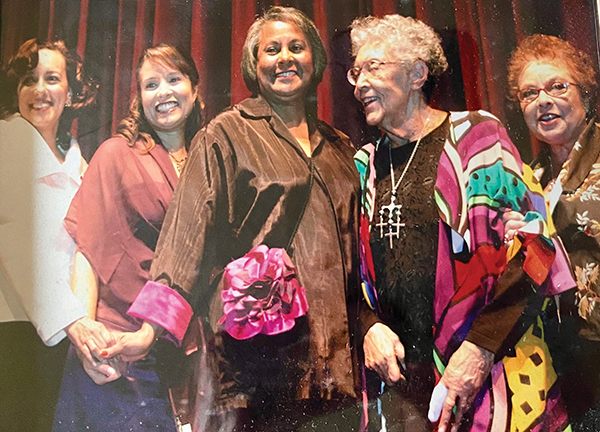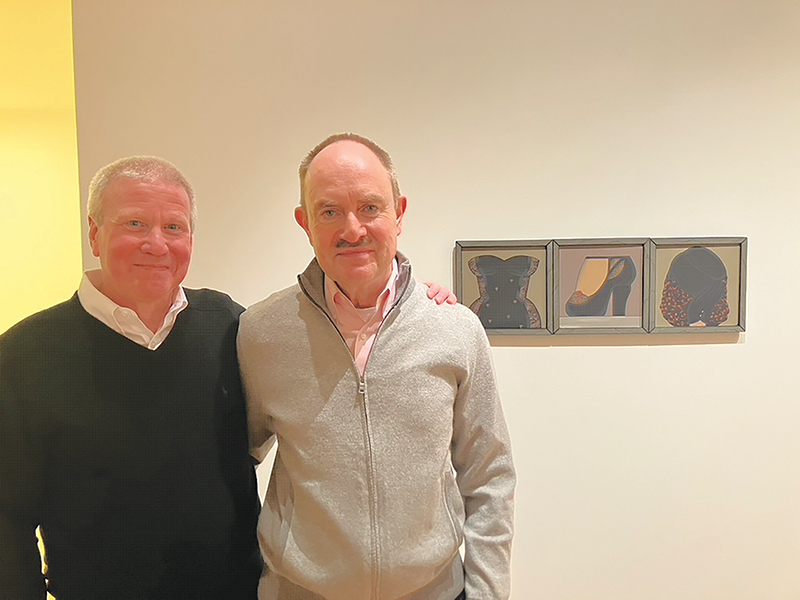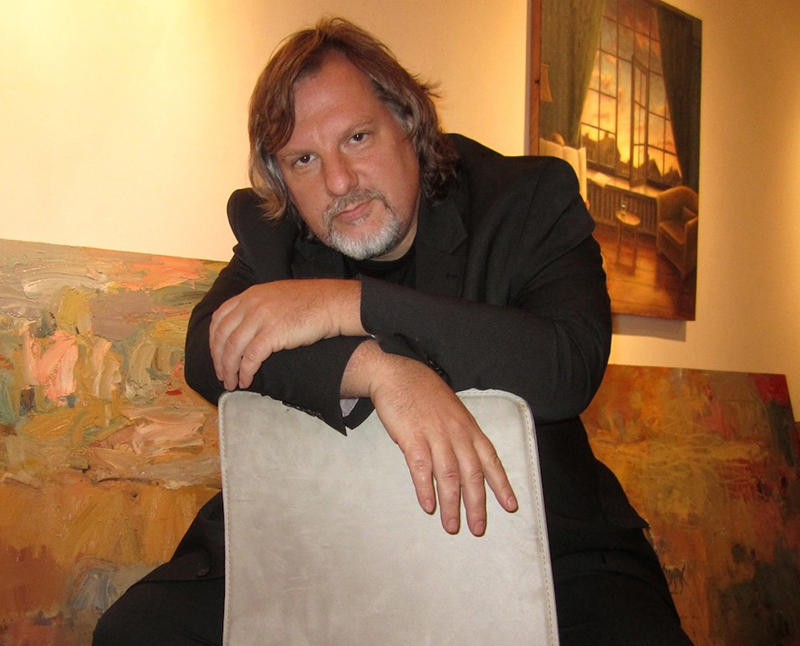R.S. Johnson: 60 Years of Art and Learning

BY GINNY VAN ALYEA
The heart of Michigan Avenue can be a chaotic, visually draining place, but nine floors up from the corner of Michigan and East Erie is an elegant space filled with hundreds of art history’s most important and valuable works. Testaments to human artistic achievement line the walls. In a coat and tie seated at a partner’s desk along the windows overlooking the Magnificent Mile is Stanley Johnson, the gentleman who has researched, collected and shared these works with the world, a vibrant intellectual who has led a life filled with language, learning, and art. From Northwestern University to travels throughout Mexico, Peru, Costa Rica, and Ecuador, followed by nearly a decade and a half in Europe, Mr. Johnson earned a reputation as a Renaissance Man. Mr. Johnson was formally recognized for his artistic contributions by France’s Minister of Culture as an Officer of Arts and Letters. He is the only United States art dealer who has been so decorated, and in the Midwest there’s only one other person who’s received the same honor, and that’s Douglas Druick, the current President of the Art Institute of Chicago. Johnson has placed art in more than 60 museums around the world, and he has published and mounted over 100 fine art exhibitions. In 2015 Mr. Johnson, with his wife Ursula, marks the 60th anniversary of the gallery his father started in 1955.

Stanley Johnson always loved being a student, but his journey to becoming a renowned art dealer was a circuitous one. From a young age he loved to travel – in some cases by bus, truck or traded horse, encountering friends, mentors, foreign ministers and even lethal anaconda snakes and earthquakes.
After a year studying art and architecture in Mexico City and a degree from Northwestern, Johnson ultimately arrived in Geneva, Switzerland in the mid-1950s to continue his study of art history. Following two semesters of art and philosophy in Geneva, Johnson went to France where he volunteered for the US Army; after basic training stateside, he was recruited to be a spy for the CIA in Vienna at the end of the occupation (his official title was Assistant Liaison Officer in Vienna), largely because of his extensive travels and language aptitude, something the army valued when they requested he attend cocktail parties to eavesdrop on foreign generals. Johnson says he was a total failure as a spy, but he was a very capable interpreter for the U.S. Commanding General in Vienna at the time. It was a wild time in his life and in the world.
Not content to be fluent in just French and Spanish, Johnson wished to improve his German, as well as his archeology and history studies, citing the language as a big block in his learning to date. He even promised a Northwestern German professor that in exchange for accepting a passing grade, he would never take another German course, as the professor said he was not capable of learning it.
His decision then to move to the University of Innsbruck in Austria would lead him to his future wife, Ursula, a beautiful young German girl who was doing post-graduate work in art history. Johnson’s German improved considerably – he says he spoke with his mother-in-law only in German, though he and Ursula communicated in French, which he still considers their best means of expression.
Together, Johnson and Ursula returned to the University of Vienna, where Johnson moved on to study ancient Greek. From Vienna, they went to Perugia, Italy to study Dante for nine months. And From Perugia Johnson went to Florence while Ursula spent time at home in Düsseldorf.
It was in Florence that art history truly began to permeate Johnson’s existence. Every morning he went to the Uffizi Museum and spent the next six hours, every day for 3-4 months, looking at each painting. He recalls, “I looked at each stroke. I became extremely familiar with the paintings there, and I always listened to what people had to say when they looked at those paintings.”
Eavesdropping in this case offered insights into global perspectives floating through the museum. Johnson observed some key lessons in looking at art: “The French had important things to say, but they all had the same things to say. The Germans had interesting and profound ideas, but they were all the same ideas. The Americans, on the other hand, could stand in front of the same paintings, and though they might not have intelligent or sophisticated ideas, they were often ridiculously silly, it was people from the new world who from time to time would offer a discovery about why something was truly beautiful. They looked at the art with an open mind.”
Johnson cites a Texas man’s blunt observation that a Michelangelo resembled a poster as an ‘ah-ha’ moment. Johnson had been trying to determine why he never really liked the work, and in fact it was as the man said – it lacked a third dimension. Today, Johnson says, “I’m still fighting for a freshness of vision. One of the reasons [the gallery has] one of the greatest art collections in the world, you see, is because I’ve been able to see things in advance.”

Johnson’s father, S.E. Johnson, started the gallery in 1955, at 224 South Michigan Ave. when he bought a gallery that was for sale in the Roosevelt University building. In 1963 when the 645 N. Michigan Ave. building was built, the gallery moved north and took over half of the second floor. (Note: About a year ago the gallery moved to the ninth floor to a more intimate space largely due to the proportion of internet business the gallery now does.) Ursula recalls that the fall evening on which the gallery was first opening at the new address was on a Friday in November 1963; it was the night JFK was assassinated. “We were actually in Paris, and even from there we were shivering. It was a very bad November, and it was all quite memorable.”
In the gallery’s early days, the elder Mr. Johnson came to visit his son in Paris. Stanley and Ursula were living in Saint-Germain-des-Prés on the sixth floor of a 17th century walk-up, then the Hôtel de Verneuil, and as Johnson notes, there was cold, running water only down on the second floor. He says, “It was total misery, except we could look down towards the Louvre. When my father asked what would happen if there were a fire, I said I’d never thought about that. He said, ‘Well I have. Let’s go downstairs and have a cup of coffee.’ He didn’t want to be there one more minute.”
In the building’s defense, Ursula points out that it had been standing since the time of Louis XIV, most likely because the cement over old wood didn’t burn more than anything else would have. She says the building is still there today, though not the hotel.
Despite their transatlantic separation, Johnson began to work for the gallery from Paris, taking advantage of his proximity to some of the great minds and talents of the 20th century. When Johnson’s father said that he would love to show Jean Cocteau’s art in Chicago, he recalls, “I went downstairs to the corner café to use the phone, and I looked up in the telephone book: ‘Cocteau, Jean.’ When he answered, I told him my father had a gallery in Chicago and he wanted to do a show of his ceramics and drawings. He said, ‘I’d love to do it. But unfortunately today, morning, noon and night, I’m busy. Come to my house for tea tomorrow.’” The Chicago exhibition was quite successful, and it was just the first of several significant art dealings started from his neighborhood café.
Johnson traveled next to Rome with his parents. The trio arranged to meet Giorgio de Chirico while there and spent an afternoon speaking to him in French and Italian along with his wife.
Johnson says, “They just loved the three of us; we got along tremendously. My father bought 24 de Chirico paintings for $12,000. At the end of that whole thing, de Chirico said, ‘We love the three of you and would like to have you to dinner at our country house tomorrow. You must promise not one word about business – strictly friendship, friendship, friendship.’” It would be an important lesson for the younger Johnson on how to do business.
Following the successful visit, the 24 purchased paintings were sent back to Chicago for the gallery exhibition. Not one was sold.
Johnson admits, “That was a disaster. $12,000 at that time was a lot of money. My father wrote a letter to de Chirico, which I have, that said the reason nothing sold was because all the paintings had bad subject matter, so he wanted to exchange all 24 for new ones. de Chirico responded that it was not because of bad subject matter, it was because he was a bad art dealer. He did exchange six paintings, and one by one they sold for $950-$1,150 until finally all 24 were sold. Today the same ones at auction go for $300,000-$400,000.
From Paris Johnson, selling art was not yet Johnson's primary pursuit; the majority of the time he continued studying art history and philosophy alongside Ursula, learning from academic stars like André Chastel, one of the greatest art history professors of 20th century, at the Institute of Art and Archeology at the Sorbonne, and under Jean Wahl, also at the Sorbonne.
Mr. and Mrs. Johnson returned from Paris for good after Stanley’s father died suddenly in 1967. When I ask him if he had a different vision for the gallery than his father, he says, “It was a commercial gallery. [My father] did some terrible things and sold some junky stuff, but gradually we got some better things. Bad things could pay the rent for awhile.”
Johnson reflects that his opportunity to be a student was very different from his father’s. “When I was in Florence, he wrote me a letter saying, 'We are your parents and we are paying for you. What are you doing? What’s keeping you there?' I wrote back that I’m doing absolutely nothing and I intend to stay for two more months doing absolutely nothing (I was also there because of the GI Bill.) When I came back to Chicago, I told him I’d been at the Uffizi from 10am-4pm each day; his reaction was, ‘That’s wonderful. I’d love to be able to do that but I can’t get away from my business.’ Ultimately he appreciated what I was doing.”
Johnson’s language, travel and art knowledge were building blocks for the time when he would run the gallery.
When he and Ursula took the helm following the senior Mr. Johnson’s death, they brought their scholarly, worldly perspective to art research, collecting and selling. Notably, in 1991 the gallery mounted a Cubist exhibition at The Phillips Collection in Washington, D.C., the Minneapolis Institute of Arts, and the Dallas Museum of Art. In 1992 Johnson’s companion book, Cubism & La Section d’Or: Reflections on the Development of the Cubist Epoch 1907-1922 was one of ten books nominated for the Alfred H. Barr Jr. Award for museum scholarship. Since 1991. He is currently close to submitting a revised version to publishers in London.
Mr. Johnson’s gallery specializes in a range of art, but the focus has long been on Post-Impressionism, Cubism and Expressionism (though an exhibition of contemporary paintings by Milwaukee artist Bruce Dorow opens May 1.) Johnson says they are always acquiring works, “We have to take time to decide what we will acquire. We don’t acquire works because they’re saleable - we have no interest in that. We determine if they’re in an interesting category of works and if we would like to own those works. If so we can go to our best friends and say we bought this and think this is a wonderful thing. We think we’re pretty exceptional that way. That’s the way we’ve been running the gallery.”

He continues explaining why the gallery deals in say, Old Master prints vs. paintings, “Old Master paintings is a bad category for us because there aren’t any more great ones left. Our collection of drawings out of France, of Picassos, may be the greatest private collection of its sort in the United States. We reject the category of Old Master drawings when they go back to say, the 16th century or before, but when you get up to the end of the 17th century or into the 18th we still buy things in which we’re interested. Old Master prints are still fantastic and there’s still a possibility to buy things for relatively accessible amounts of money. We’re dealing more with European art than American art, and our competition is essentially European. As a result we have to outfox, out maneuver and out connoisseur European competitors, which is a fun challenge easily met, for the very reason I explained when I visited the Uffizi – the Europeans tend to have preconceived notions of what’s this and what’s that. They can’t conceive of some American knowing more about what they live with.”
What else makes this market so appealing to Johnson? Camaraderie, knowledge and competition. Johnson excitedly explains, “The Old Master Print market consists of auctions in London - where it all started. You’ve got the round table with the green velvet top and the work is being offered - there are ten dealers seated and they are all European, except me. The winner is the one who got the best deals in buying those things, not he one who has the most money. It doesn’t have much to do with who has the most money but the one who has the best eye. The other thing is that for an individual to be brought into that world is a difficult thing. You also can’t just have anyone show up since it’s a rare thing. Much of it is about friendship, friendship, friendship.”
Johnson attests that each work in his private collection has a story. He lists artists most of us encounter only in world famous museums: Toulouse-Lautrec, Bonnard, Jacques Villon and Matisse. So, where did they come from? Johnson is eager to tell the story of another friendship he forged in Paris, one with Daniel-Henry Kahnweiler, Picasso’s art dealer. As a result of his place within an intellectual group in Paris, which included Kahnweiler and others, Johnson eventually became one of the direct dealers of Picasso. In 1970 Kahnweiler, in his 90s at the time, had 120 drawings, watercolors and pastels of Picasso’s to unload, and there were nine dealers from around the world, including Johnson, who had first choice. Johnson clearly recalls, “I arrived at Kahnweiler’s Paris studio about an hour before this sale. I said to him, ‘It’s wonderful to be one of these nine, but I’m the ninth one as well as the youngest. Wouldn’t it be wonderful to take any drawing I want?’ He responded, ‘Monsieur Johnson, if it’s that important to you, go in there and take any drawing you want, but don’t tell the other dealers, and don’t leave it in the room – put it in my office so they don’t see it. You must promise me two things: the drawing you pick today, you will never sell. And every time you look at that drawing you tell yourself what a great guy Kahnweiler was.’”
Towards the end of our conversation, Mr. Johnson stops to ask me if I’m having fun. He continues, “I’m always having fun, and I enjoy the competition.”
Johnson’s career as a world traveler, a student of art history and an art dealer has been filled with stories and great relationships. His greatest partner of all has undoubtedly been his wife, his intellectual as well as business companion and the reason he finally mastered German. About Ursula he shares, “She is quiet, but she is very, very knowledgeable. We have formed the collection. It’s been a whole life together.”






